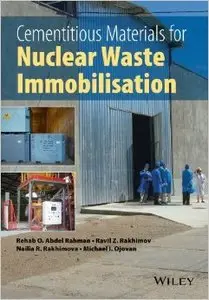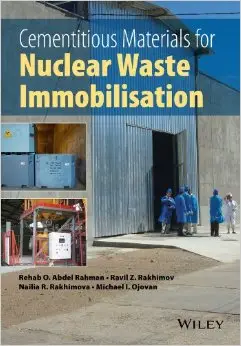Rehab O. Abdel Rahman, Ravil Z. Rakhimov, "Cementitious Materials for Nuclear Waste Immobilization"
2014 | ISBN-10: 1118512006 | 258 pages | PDF | 7 MB
2014 | ISBN-10: 1118512006 | 258 pages | PDF | 7 MB
Preface
Approaches and current practices of use of cementitious materials for nuclear waste immobilization are summarized in this book, with a focus on the most important aspects of cements as nuclear wasteforms. The topics covered include an introductory background on nuclear waste management, description of Portland cements and cements with mineral and chemical admixtures, alternative cementitious binders, radioactive waste cementation and equipment used, wasteform durability requirements and testing, and performance assessment.
Hydration of Portland cement as well as interaction of Portland cements with water and soil are described in detail. Also covered are mineral and chemical admixtures, chemical admixtures to control the structure and properties of Portland cements such as accelerators and retarders, plasticizers, and super-plasticizers, air-entraining agents, water-retaining agents and water permeability reducing admixtures, biocidal admixtures, mineral admix-
tures in the control of the composition, structure and properties of cements and mineral admixtures from natural rocks and minerals. Alternative binders are considered including calcium aluminate cements, calcium sulphoaluminate cements, phosphate cements such as magnesium and calcium phosphate cements, as well as alkali-activated cements. Cement properties relevant to waste immobilization are analysed including characterization and
testing.
Radioactive waste streams suitable for cementation are described including both aqueous and organic waste, bulk and fragmented (dispersed) solid wastes as well as the description of cement-based wasteform optimization. Waste cementation technology and equipment are considered including methods of liquid and dispersed solid waste cementation and methods for cementation of bulk solid waste. Quality control of technological processes and materials obtained is discussed.
Cementitious wasteform durability requirements are examined along with the role of material performance and expected performance of cements. Wasteform leaching parameters and testing protocols such as IAEA/ISO 6961-82, ASTM C1220-98 (MCC-1), ANS-2009 (ANS/ANSI 16.1) and ASTM C1662-10 are given. Long-term field tests of cementitious materials are described as well as the effects of radiation, biological activities and role of
filling materials. Performance assessment gives a brief overview of historical disposal practice, disposal facility design, modelling approaches, and safety case developed for disposal facilities.
Overall the book provides the reader with both a scientific and technological basis of using cementitious materials for immobilization of nuclear waste.



